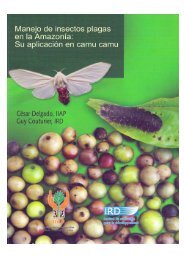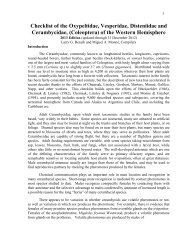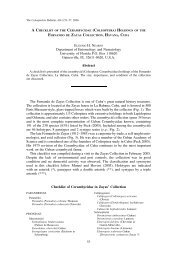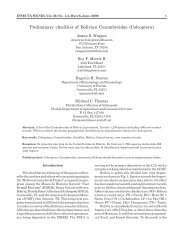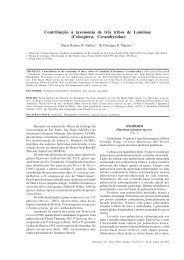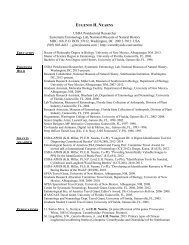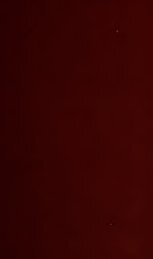Create successful ePaper yourself
Turn your PDF publications into a flip-book with our unique Google optimized e-Paper software.
LAWRENCE S. DILLON <strong>AND</strong> ELIZABETH S. DILLON 41<br />
irregularly clothed with somewhat brighter fulvous-brown pubescence; abdomen<br />
medially fuscous, thinly puhescent, laterally broadly vittAte with fulvous-brown.<br />
Legs fuscous, thinly fulvous-brown pubescent, mctsfemora medi:111y indistinctly<br />
annulate with darker brown; tarsi entirely, finely gray pubesceut. Antennae dark<br />
reddish brown, bases of segments from fourth narrowly roseate, scape fuseom;<br />
proximal three segments and roseate bases of others gray pubeseent, apical portion<br />
of fourth and following covcred with nne brown pubescence.<br />
He3d minutely puncta.te, wilh a fine median line from occiput almost. to<br />
episterna; front comparatively wide and concave between antennal tubercles, sides<br />
grodunlly widened bclow, minutely and densely punctate, with finc punctures interspersed;<br />
genae elongate, vertical, punctate as front; eye with lower lobe broadly<br />
oblong, short, not quite equal to gem). in height ; antennal tubercles feebly elevated,<br />
small, well separated, apices acute nnd not dentate. Pronotum transverse, sides<br />
strnight, tapering to apex, uD9.rmed; apical transverse sulcus brand, shallow, basal<br />
one narrower, joining t.he indistillct, latcrll.\, oblique sulcus each side; disk finely<br />
punctate across base, with fIVe smull but prominent tubercles, median one longest,<br />
most lateral ones least elevated, slightly oblique. Scutellum transverse; sides<br />
slightly rounded, feebly oblique; apex broad and arcuate. E1ytra with sides almost<br />
parallel behind humeri, after middle gradually, arcuately narrowed to apices, which<br />
are separately ronnded; gibbosity of base prominent, nearly eireubr in outline,<br />
irregularly granulate-punctate, the punctures coarse, the granules feeble, basaUy<br />
more distinct, re:.;' of oo.se behind usual smooth space more finely and sparsely<br />
punctate, a row {If coarse Olles between gibbosity and suture, punctures more<br />
obsolete behind middle; humeri prominellt, anterior margin straight, somewhat<br />
oblique, angle with a In.rge, prominent tubercle, behilld which the sides arc straight,<br />
slightly tapering, alld briefly carinate; sides below and behind humeri very coarsely,<br />
densely punctate to middle, punctures thence strongly obsolescent. Prosternum<br />
simple, rather Il!Lrrow. Procoxo.e slightly tumid behind, allteriorly with a very<br />
small tubercle; femora ci.n.vate, the rncsofemora most strongly so, profemora elongate,<br />
not at all rugose; metatibiac not mucll enlarged apically. Fifth sternite twice<br />
length of fourth, apex truncate, apical impre5sion broad and shallow, basally<br />
becoming linear and more distinct. Antennae distinctly longer than body, sparsely<br />
fringed beneath on proximal five segments; scape slender. gradually cl:tvate apically<br />
Irom bcfore middle, not rugose; third segment distinctly, but not. strongly, bisinuose.<br />
LEKQTH 15.5 mm.; width 6.5 mm.<br />
Type locality.-Ega, Brazil.<br />
Distribu.lion.-Amazon Valley of Brazil.<br />
BRAZIL : "' ; Santarem; [C.M.J.<br />
Hypsioma inornata Thomson<br />
PLATE II, FIGURF. 15.<br />
Hypaioma inornata Thomson. Physis, II, 1868, p. 49.<br />
Head, pronotum, and basal fourth of elytra black, rest of elytra<br />
dull olive green j humeri projecting, with an ungulate carina j clytra



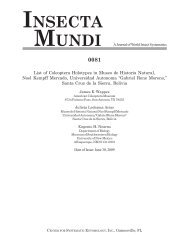
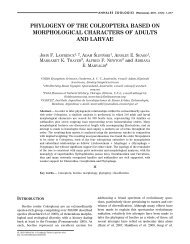


![Coleoptera. Vol. I. [Longicornia. Part I.]](https://img.yumpu.com/41202793/1/180x260/coleoptera-vol-i-longicornia-part-i.jpg?quality=85)
